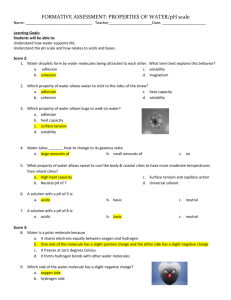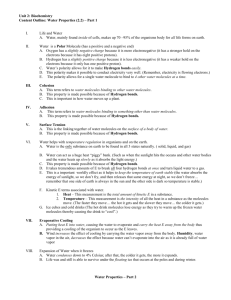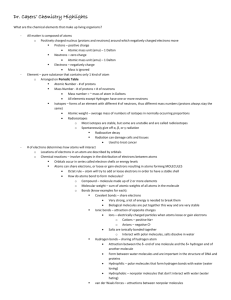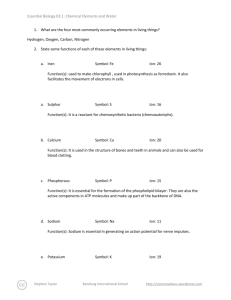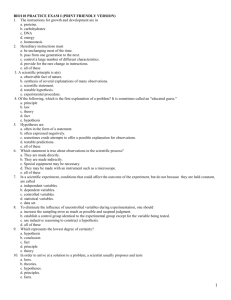Test 1 biology
advertisement
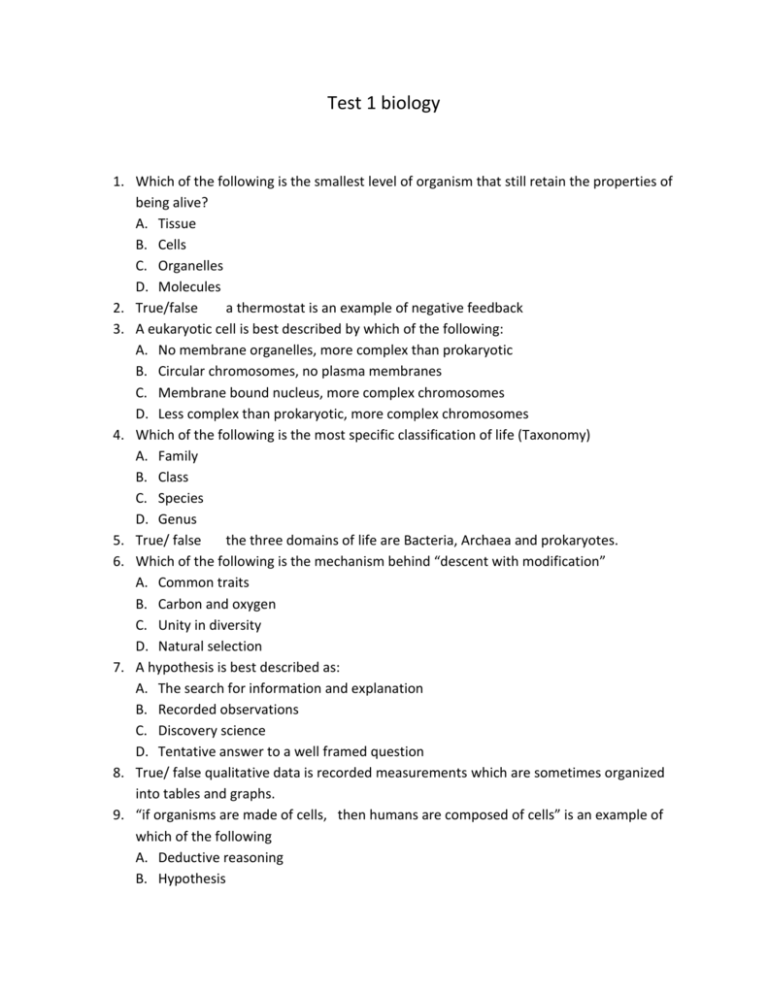
Test 1 biology 1. Which of the following is the smallest level of organism that still retain the properties of being alive? A. Tissue B. Cells C. Organelles D. Molecules 2. True/false a thermostat is an example of negative feedback 3. A eukaryotic cell is best described by which of the following: A. No membrane organelles, more complex than prokaryotic B. Circular chromosomes, no plasma membranes C. Membrane bound nucleus, more complex chromosomes D. Less complex than prokaryotic, more complex chromosomes 4. Which of the following is the most specific classification of life (Taxonomy) A. Family B. Class C. Species D. Genus 5. True/ false the three domains of life are Bacteria, Archaea and prokaryotes. 6. Which of the following is the mechanism behind “descent with modification” A. Common traits B. Carbon and oxygen C. Unity in diversity D. Natural selection 7. A hypothesis is best described as: A. The search for information and explanation B. Recorded observations C. Discovery science D. Tentative answer to a well framed question 8. True/ false qualitative data is recorded measurements which are sometimes organized into tables and graphs. 9. “if organisms are made of cells, then humans are composed of cells” is an example of which of the following A. Deductive reasoning B. Hypothesis C. Inductive reasoning D. Inquiry 10. In the context of science a theory is A. Broader in scope than a hypothesis B. General, and can lead to new testable hypothesis C. Supported by a large body of evidence D. All of the above 11. Which elements make up 96% of living matter A. Carbon, nitrogen, hydrogen, oxygen B. Carbon, nitrogen, calcium, hydrogen C. Calcium, oxygen, hydrogen, nitrogen D. Chlorine, hydrogen, helium, carbon 12. True/ false compounds have characteristics different from those of its elements 13. An atomic number is based on the A. Number of protons in the nucleus B. Number of compound it contains C. Number of both neutrons and electrons D. Number of electrons in the nucleus 14. An elements mass number can be determined by A. The product of protons and neutrons B. The sum of electrons and protons C. The sum of protons and neutrons D. The product of protons and electrons 15. True/ false an object on a shelf has less potential energy than one on the ground 16. Which three elements have full valence shells A. boron, carbon and oxygen B. Magnesium, fluorine and chlorine C. Hydrogen, lithium and sodium D. Helium, neon and argon 17. What is the valence of each starting at hydrogen A. 1,6,5,3 B. 1,2,3,4 C. 4,3,2,1 D. 1,5,6,4 18. How many electron “seats” are in each of the three shells? A. 3,6,6 B. 3,8,8 C. 2,8,8 D. 2,6,6 19. True/ false covalent bonds are the strongest valence bonds 20. An example of a covalent bond that is non-polar is A. Carbon and oxygen B. Oxygen and hydrogen C. Carbon and hydrogen D. None of the above 21. a charged atom or molecule is called a A. ion B. cation C. anion D. all of the above 22. attractions between molecules that are close together as a result of random charges is defined as (hint: remember the gecko analogy) A. bonds B. electronegativity C. reactants D. Van der Waals interactions 23. Chemical equilibrium is A. All reactions cease to occur B. Forward and reverse rates are equal C. All compounds are equal in measurements D. None of the above 24. True/ false cells are comprised of 70-95% water 25. True/ false water molecules are polar (each end has different charges) 26. Cohesion is best described as A. Attraction between different substances B. Hydrogen bonds that hold water molecules together C. Expansion of cells D. Reverse photosynthesis 27. Adhesion is best described as A. Attraction between different substances B. Hydrogen bonds that hold water molecules together C. Expansion of cells D. None of the above 28. True/ false Water can absorb or release a large amount of heat with only a slight change in its own temperature. 29. Heat is measured by A. Average kinetic energy B. Total kinetic energy C. Photosynthesis D. None of the above 30. True/ false The specific heat of a substance is the amount of heat that must be absorbed or lost for 1 g of that substance to change its temperature by 1ºC 31. An aqueous solution is A. The dissolving agent of a solution B. A substance that is dissolved C. one in which water is the solvent D. one which water is the solution 32. True/ false A colloid is a stable suspension of fine particles in a liquid 33. A substance that has an affinity for water is A. Hydrophilic B. Hydrophobic C. Oil molecules D. Non-aqueous solution 34. (OH(-neg)) is best described as (hint: lost the proton) A. Hydrogen ion B. Hydronium ion C. Hydroxide ion D. None of the above 35. True/ false An acid is any substance that increases the H+ concentration of a solution 36. Organic chemistry is A. the study of compounds that contain carbon B. range from simple molecules to colossal ones C. contain hydrogen atoms in addition to carbon atoms D. all of the above 37. true/ false Isomers are compounds with the same molecular formula but different structures and properties 38. which of the following is true about functional groups A. components of organic molecules that are most commonly involved in chemical reactions B. The number and arrangement of functional groups give each molecule its unique properties C. None of the above D. Both A and B 39. True/ false Adenosine Triphosphate (ATP), is the primary energy-transferring molecule in the cell 40. SHORT ESSAY 41. Explain how buffers work; do humans have them, why? 42. Explain how carbon’s electron configuration explains its ability to form large, complex, diverse organic molecules 43. Distinguish among these three types of isomers: structural, geometric, and enantiomer Prepared by: Michael Hamilton, mhamilton26@ccccd.edu





